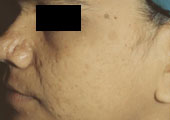| |

| Case
1 Before |
Case
1 After |
Case 2 Before |
Case 2 After |  |  |  |
|
| Dermabrasion
( 'Sandpaper Surgery' ) | | Dermabrasion
is a highly sophisticated, controlled scraping of the facial skin that is used
to smooth fine wrinkles or scars left by acne or previous surgery. |
| The
operation | | This
is done using a diamond 'fraise' ( drill bit ) or sometimes, quite simply, sandpaper
itself. I use one of the above, although others may use more complex devices like
lasers to achieve the same end. The drill bit is attached to a motorized hand
piece and rubbed against the outer layers of the skin to peel them off surgically.
Dermabrasion is generally done for the full face and stops short just beyond the
margin of the jaw bone. The eyelid skin is left untouched as it is delicate. |
| Anaesthesia |
| I
prefer General Anaesthesia so that the patient is completely unaware of all the
facial skin manipulation that is evidently required during this procedure. |
| Hospital
stay | | Generally
48 hours, as this is the period during which the skin 'weeps' the maximum after
the procedure. | | |
| Risks |
| Scarring
may occur if the dermabrasion has gone too deep, which is why I do not recommend
it for scars arising from injury. Hyperpigmentation can occur if the patient does
not adhere to the post-operative sun protection regime. |
| | | Post-operative
care | | The
patient is discharged with antibiotics, anti-inflammatory medications and a skin
care regime involving washing with soap and water and application of ointment
on the abraded areas. The patient is asked to follow up once in 3 to 4 days to
ensure that all is going well. | | |
| What
to expect | | The
'weeping' stops in a weeks time, leaving behind totally de-pigmented skin, except
for the skin around the eyes. Normal skin colour will return over a variable period
from 6 to 8 weeks. However, one will be socially presentable after about 3 weeks.
After this period, cosmetics may be used to conceal the whitened areas. One must
be prepared for this time period away from work, not to mention the rigid sun
protection protocol that is mandatory for success. | | |
| Outcome |
| I
do not perform this procedure unless I feel confident of making at least a 30
to 40 % difference to the patients scars. | | |
| |
| | |
| | |




